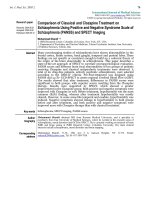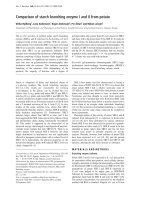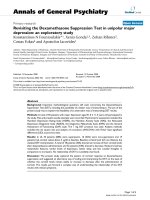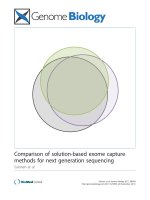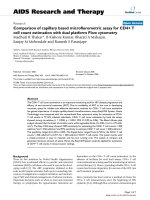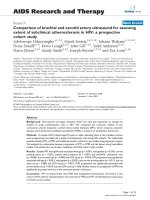Báo cáo y học: " Comparison of side effects of oxytetracycline and talc pleurodesis: an experimental study." doc
Bạn đang xem bản rút gọn của tài liệu. Xem và tải ngay bản đầy đủ của tài liệu tại đây (904.43 KB, 6 trang )
RESEARC H ARTIC L E Open Access
Comparison of side effects of oxytetracycline and
talc pleurodesis: an experimental study
Alper Gözübüyük
1
, Berkant Özpolat
2*
, Ali Fuat Çiçek
3
, Hasan Çaylak
1
, Orhan Yücel
1
, Kuthan Kavaklı
1
,
Sedat Gürkök
1
, Onur Genç
1
Abstract
Background: Chemical pleurodesis is widely recommended in the treatment of refractory pleural effusion or
pulmonary air leak of different etiologies. Although several agents have been used, many questions have remained
unanswered about their toxicity. Talc is the most commonly used agent for the treatment, with rare, serious
complications reported. Oxytetracycline pleurodesis in clinical practice has been described in a few studies, but
literature reveals no experimental studies using this agent. We performed a prospective, randomized, observer-
blinded, controlled study to evaluate the changes in lung histology and systemic response to pleurodesis with
oxytetracycline and talc in acute and subacute phases in a rat model.
Methods: Forty-two male albino Wistar rats were divided into three groups and 3 subgroups with 7 animals in
each. Group 1 was given oxytetracycline, 35 mg/kg; Group 2 was given talc slurry, 60 mg/kg in 0.5 mL saline
solution, and Group 3 was given only 0.5 mL saline intrapleurally. In subgroups “a” the nimls were sacrificed at the
postoperative 72
nd
hour and, in subgroups “b”, on the postoperative day 7. The surfaces were graded by
microscopic examination.
Results: Oxytetracycline produced alveolar collapse, hemorrhage, edema, inflammation at the postoperative 72
nd
hour and hemorrhage on the postoperative day 7, while talc produced significant edema, inflammation,
proliferation, fibrosis at the postoperative 72
nd
hour and hemorrhage, edema, inflammation, proliferation, and
fibrosis on the postoperative day 7 (p < 0,0042). Talc produced significant edema compared to oxytetracycline on
the postoperative day 7. On contralateral side, oxytetracycline and talc produced significant hemorrhage on the
postoperative day 7 (p < 0.0042).
Conclusions: Both agents were shown to produce pulmonary lesions. In acute phase, the pulmonary side effects
of oxytetracycline were more pronounced, whereas the side effects of talc were prolonged to subacute phase. We
propose that the occasional side effects in humans may be related to these changes as were observed in our rat
model, and like talc, oxytetracycline must be used cautiously in patients with limited respiratory function.
Background
Chemical pleurodesis is used to create fibrosis b etween
pleural layers and obliterating pleural spaces to prevent
fluid accumulation in malign diseases or benign diseases
such as recurrent pleural effusion in cardiac failure, cir-
rhosis, nephritic syndrome, and chylothorax. It is also
used in recurrent pneumothorax [1].
Talc is the most commonly tested and used agent for
pleurodesis worldwide. Its use was first reported in 1935
by Bethune [2]. It is cheap, widely available, easy to use,
and nearly 90% effective [3]. However, the success of
this brilliant agent has been shadowed in clinical prac-
tice and clues from experimental studies that used this
agent indicate potential risks for respiratory insuffi-
ciency, ARDS, and death [1,3-7].
Tetracycline has a wide range of efficacy (45-77%) as
well. Main side effects of tetracycline, when use d intra-
pleurally, are pain and fever. Tetracycline pleurodesis
requires heavy analgesia, but serious pulmonary and
extrapulmonary complications are not frequent [8]. Oxy-
tetracycline pleurodesis is reported in a few studies in
clinical applications but to the best of our knowledge, it
* Correspondence:
2
Department of Thoracic Surgery, Kırıkkale University, School of Medicine,
Kırıkkale, Turkey
Full list of author information is available at the end of the article
Gözübüyük et al. Journal of Cardiothoracic Surgery 2010, 5:128
/>© 2010 Gözübüyük et al; licensee BioMed Central Ltd. This is an Open Acce ss article distribute d under the terms of the Creative
Commons Attribution License ( which permits unrestricted use, distribution, and
reproduction in any medium, provided the original work is properly cited.
has not been reported in any animal studies to date
[9-11].
This prospective, randomized, observer-blinded, con-
trolled study was conducted to evaluat e the changes in
pulmonary histology and systemic alterations after
pleural administration of oxytetracycline and talc in
acute and subacute phases in a rat experiment.
Methods
Forty-two male albino Wistar rats (280-320 g, 6-8
months old) were provided by the research center of
GATA MMA of the Faculty of Medicine. All animals
received humane care in compliance with the European
Convention on A nimal Care and the study protocol was
approved by the Animal Ethics Committee of GATA
MMA (06/125). The animals were housed and operated
the animal laborat ory. Group 1 (n = 14) and Group 2 (n
= 14 ) were the study grou ps, and Group 3 (n = 14) was
the control group. The groups were further divided in
two equal subgroups as “a” and “b” based on the time of
sacrifice. In subgroups “a”, the animals were sacrificed at
the postoperative 72
nd
hour and, in subgroups “b” ,the
animals were sacrificed on the postoperative day 7 fol-
lowing the intrapleural administration of agents. In
Group 1, the animals received intrapleural oxytetracy-
cline (Pan-Terramycine, Pfizer, İstanbul. An injectable
solution, which can be applied via IV, IM, SC and IP
routes) , 35 mg/kg; the animals in Group 2, 60 mg/kg of
talc (the average particle size was 24.5 μ and fewer than
11% of the particles were smaller than 0.5 μ a ccording
to the producer) were given slurry in a total volume o f
0.5 mL saline solution. Group 3 (the control group)
received intrapleural 0.5 mL saline solution.
Surgery
The rats were anesthetized with 35 mg/kg ketamin e
hydrochloride plus xylazine hydrochloride 5 mg/kg,
administrated intramuscularly and under sterile condi-
tions; a 5 mm skin incision was made over the seventh
intercostal space. Oxytetracycline and talc slurry were
introduced via a 16-gauge PTFE catheter into the left
pleural space. The presence of air in the pleural space
was checked, and if any, it was evacuated by using a
three-way stopcock, and then the catheter was removed.
The animals were rotated to assure distribution of
agents to the entire pleural surface. The control group
received intrapleural saline by the same method. The
musclesandtheskinwereclosedsequentiallywith3/0
silk sutures. Animal movements were observed during
the wake-up period for evidence of discomfort and pain
(vocalization, tachypnea and restlessness), and when
necessary, they received buprenorphine 1.3 mL, subcuta-
neously. The animals were maintained in adequate cages
and fed according to the protocol of the animal
quarters. There were no surgery related deaths or
complications.
Autopsy
Autopsies were performed by one of the investigators,
who was blinded to the treatment received by the ani-
mals. In Groups 1a, 2a and 3a, the animals were sacri-
ficed after 72 h, in groups 1b, 2b and 3b on day 7,
under general anesthesia.
Microscopy
Sections of the chest wall and both lungs were tak en in
the anteroposterior plane in the midlung zone includi ng
the mediastinal structures. The entire ipsilateral lung, en
block chest wall with ipsilateral hemidiaphragm, as well
as contralateral lung, heart with enblock mediastinal
structures, chest wall, liver, and kidneys were collected:
All were t hen placed in 10% buffered f ormalin, an d the
above mentioned samples were stained with hemotoxylin-
eosin. Microscopic analysis was done by a pathologist
blinded to the groups. The degree of microscopic lung
disturbance characterized by alveolar collapse (i.e., collapse
of the framework involving alveolar sac and ducts leading
to an overlap of the alveolar septa a nd reduction of the
space for gas exchange), alveolar hemorrhage (i.e., blood
inside the alveolar spaces blurring the background struc-
tures), edema (i.e., proteinac eous and amorphous mate-
rial inside the alveolar space), cellular infiltrate (i.e., total
number of cells in the alveoli) w ere evaluated as
described by Vargas et al [ 3]. These parameters were
subjectively semiquantified by a histopathologic score
according to the extension and severity of the histo-
pathologic lesions present in the lung tissue. The scoring
was as follows: Grade 0, absent; grade 1, slight; grade 2,
mild; grade 3, moderate; and grade 4, severe [3]. All the
specimens in the talc group were submitted to polarized
light with the purpose of investigating birefringent talc
particles and were scor ed as 0; negative and 1, po sitive.
The contralateral hemithorax was studi ed for the above
mentioned changes. Macroscopical analysis was also
done by the same pathologist blinded to the groups. As
the sacrification time is short no dense adhesions were
expected so the presence of adhesions was evaluated as
no adhesions or minimal adhesions. Surrounding tissues
(the diaphragm, liver, kidney, hearth, chest wall) were
also examined.
Statistical Analysis
Data analysis was performed by using SPSS for Win-
dows, version 11.5 (SPSS Inc., Chicago, IL, United
States). The data were shown as median (minimum-
maximum). The differences among the groups were
evaluated by Bonferroni Adjusted Kruskal-Wallis test.
A p value less than 0.0125 was considered statistically
Gözübüyük et al. Journal of Cardiothoracic Surgery 2010, 5:128
/>Page 2 of 6
significant. When the p value from Kruskal-Wallis test
was statistically significant, Mann Whitney U multiple
comparison test was used to determine the group that
caused the difference. A p value less than 0.0042 was
considered statistically significant. Whether the differ-
ences between days and lateralization were statistically
significant or not were determined by Bonferroni
Adjusted Mann Whitney U test.
Results
Intrapleural administration of talc slurry did not cause
distress in any of the animals, but after oxytetracycline
instillation, 12 animals developed spasm, which indi-
cated pain. These animals were supported with subcuta-
neously administered buprenorphine. All the subjects
rapidly regained normal feeding and returned to normal
activities.
Macroscopy
When the pleural spaces were opened, there were only
minimal adhesion at injection side between the pleural
layers in 3 rats in talc injected group at the postopera-
tive 72
nd
hour. The lungs and other organs seemed nor-
mal. Visible talc deposits up to size of 1 mm were seen
on the pleural surfaces in 8 subjects in the talc instilled
groups.Exceptforthelungs,notalcparticleswere
found in any of the visceral organs.
Microscopy
Reactions to agents were in patchy manner in oxytetra-
cycline groups, but diffuse and relatively more dense
and severe in talc injected groups. The extension and
distribution of the parenchymal changes were not
homogeneous throughout the pulmonary tissue. Oxyte-
tracycline produced significant alveolar collapse, hemor-
rhage, edema, inflammation compared to the control
groupatthepostoperative72
nd
hour (p < 0.0042) (Fig-
ure 1). Oxytetracycline produced significa nt hemorrhag e
compared to the treatment in the control group on the
postoperative day 7 (p < 0.0042) (Figure 2). Talc pro-
duced significant edema, inflammation, proliferation,
fibrosis compared to the treatment in the control group
at the postoperative 72
nd
hour (p < 0.0042). Talc pro-
duced significant hemorrhage, edema, inflammation,
proliferation, fibrosis compared to control group on the
postoperative day 7 (p < 0.0042) (Figure 3). Talc pro-
duced significant edema compared to oxytetracycline on
the postoperative day 7 (p < 0.0042). On the contralat-
eral side, oxytetracycline and talc produced significant
hemorrhage on the postoperative day 7 and talc pro-
duced significant edema both at the postoperative 72
nd
hour and on the postoperative day 7 when compared to
control group (p < 0.0042). The contralateral pleural
surface, the liver, and the diaphragm of the animals did
not show any inflammation. The scores of the micro-
scopic exam of hematox ylin and eosin stained lung par-
enchymaofalltheanimalsareshowninTable1.No
significant differences for birefringent talc p articles were
found in the talc group. Another important result of
this study was although the pleural proliferation and
fibrosis were significant in the talc group during acute
and subacute phases, in the o xytetracycline group, no
such changes were observed.
Discussion
Chemical pleurodesis is generally superior to mechanical
pleurodesis in general practice because of its easy appli-
cation without the need for general anesthesia, short
Figure 1 Microscopic section of lung parenchyma exposed to
oxytetracycline. In the acute phase early signs of inflammation and
alveolar collapse are seen. Hematoxylin and eosin, 200×.
Figure 2 Microscopic section of lung parenchyma exposed to
oxytetracycline. In the subacute phase signs of intraalveolar
hemorrhage and alveolar collapse are seen. Hematoxylin and eosin,
200×.
Gözübüyük et al. Journal of Cardiothoracic Surgery 2010, 5:128
/>Page 3 of 6
hospital stay, and low cost. Many agents that are widely
available, cheap, easy to use, effective, and/or safe have
been defined for pleurodesis in literature [1,12]. How-
ever, none of these agents meets all these criteria [13].
Pleurodesis may affect neighboring or distant organs
and tissues extrapleurally. Complications of pleurodesis
were reported to be the most common with talc and tet-
racycline derivates [12,14].
The mechanism o f transportation of chemical agents
to the extra pleural organs is not well described, and the
lymphatic way i s one of them. The subpleural space of
the visceral pleura and parietal pleura has a large net-
work of lymphatic channels; the lymphatic drainage of
the visceral pleura is primarily to the deep pulmonary
plexus located in the interlobar and peribronchial spaces
[15]. It was postulated that absorbed materia ls moves
into the lymphatic system and are transported to the
mediastinal lymph nodes and thoracic duct and finally
to systemic circulation [5]. Another hypothesis is the
acute pneumonitis, which is related to the systemic
absorption of especially smaller talc particles and the
subsequent inflammatory reactions in the lungs [7]. It
hasbeendemonstratedinanimalmodelsthatsystemic
absorption of talc causes distant embolisation to the
lungs, liver, spleen, brain, kidney, heart, skeletal muscle,
and even the brain [6,7]. It has been shown in many
experiments that pleura as a barrier between pleural
spaces and lung parenchyma is destroyed after the instil-
lation of agents used for pleurodesis, which leads to
transple ural diffusion. By this way, the agent may easily
penetrate into the lung parenchyma and cause unwanted
side effects [6].
In the light of these facts, this rat model was devel-
oped to determine whether oxytetracycline may cause
lung damage like talc in acute and subacute phases of
chemical pleurodesis.
Our results support that both agents must be used
cautiously and should be avoided in patients with lim-
ited pulmonary reserve. These changes were observed
with both oxytetracyc line and talc administrations and
in the acute and subacute phases due to systemic distri-
bution. Moreover, morphologic changes were observed
on the contralateral side.
Well-documented side effects of talc pleurodesis are
fever (16-69%) and chest pain (7%). After intrapleural
administratio n as slurry or insuff lation, serious pulmon-
ary complications, including acute pneumonitis, acute
respiratory failure and ARDS with different incidences
ranging between 0% and 33% have been reported [7],
and in some cases, this complication was lethal [6]. Pre-
vious experimental studies demonstrated pleural and
pulmonary acute inflammatory responses to talc pleur-
odesis, which were pleural thickening, fibrin deposition
in areas of mesothelial denudement and transient mono-
nuclear vasculi tis noted in rabbit lung [6,16]. Montes et
al also found focal inflammatory responses around of
talc particles, capillary vasodilation and hyperemia in
pulmon ary parenchyma and foreign body granulomas as
a conseque nce of pleural talc depositions [17]. However,
in some studies, no significant histological alteration
was found within the subjacent lung parenchyma
[18,19]. In our study, talc produced significant alveolar
edema and inflammation in the acute phase and in the
subacute phase, these changes were added by alveolar
hemorrhage. In this study, the inflammation of contral-
ateral lungs was also shown in detail. On the contralat-
eral side, it produced significant edema in the acute
phase and hemorrhage and edema in the subacute
phase. Considering the high rate of contralateral changes
reported after talc poudrage we could at le ast theoreti-
cally justified the occurence of ARDS. In a rabbit study,
birefr ingent talc bodies were found in abdominal organs
in 15-40% of the animals studied, and another study
showed that all the extrathoracic organs contained bire-
fringent talc particles [4,16] . In our study , no significa nt
differences were found in the talc group when compared
to the control group for birefringent talc particles.
For tetracycline pleurodesis, the most commonly
reported adverse effects were pain and fever. Tetracy-
cline requires sedation with benzodiazepines or analge-
sia with a narcotic drug. In addition, vestibular
symptoms and after high doses, hemothorax were
observed in animal studies [14,20]. After tetracycline
pleurodesis, systemic absorption led to acute renal fail-
ure and hepatotoxicty i n animal models, and similar to
talc, the administration of a tetracycline derivative doxy-
cycline was reported to lead to the development of the
acute respiratory distress syndrome and even death [21].
Figure 3 Microscopic section of lung parenchyma exposed to
talc at subacute phase. Signs of inflammation and birefringent talc
particles are seen. Hematoxylin and eosin, 200×.
Gözübüyük et al. Journal of Cardiothoracic Surgery 2010, 5:128
/>Page 4 of 6
Wooten et al showed that tetracycline was systemically
absorbed following intrapleural inst illation. They
explained the entrance of these agents beyond the extra-
pleural space and systemic circulation by/with lymphatic
absorption from pleural surfaces and by exposing the
subpleural microvessels and microlymphatics of the
loose connective tissue layer directly to the contents of
the pleural space by denudement of mesothelial cells
after administration of sclerosing agents [22]. After the
discontinuation of production o f the injectable tetracy-
cline hydrochloride by the manufacturer, alternative
forms like doxycycline and minocycline have been used
for pleurodesis [1,13,14].
Oxytetracycline, a derivative of Streptomyces rimosus,
wasintroducedin1950andhasbeenaneasilyaccessi-
ble drug in Turkey [10]. However, it was published in
few clinical studies probably due to some ethical reasons
[9-11]. Furthermore, there are no experimental studies
Table 1 The scores of microscopic examination of groups.
Ipsilateral Contralateral Multiple Comparisons
c
OT Talc Control p
a
OT Talc Control p
b
p
d
p
e
p
f
AC
72 h 1 (0-1) 1 (1-2)
h
0 (0-1)
h
0.012 0 (0-1) 1 (0-1) 0 (0-1) 0.240 0.317 0.059 0.564
7 day 1 (0-1) 2 (0-4) 0 (0-1) 0.081 0 (0-1) 1 (0-4) 0 (0-1) 0.053 0.655 0.414 0.564
p
g
1.000 0.535 1.000 0.710 0.259 1.000
Hem
72 h 1 (0-3) 2 (1-2)
h
0 (0-0)
h
0.002 0 (0-1) 1 (0-2) 0 (0-0) 0.067 0.119 0.038 1.000
7 day 1 (1-2)
i
2 (1-4)
h
0 (0-0)
h.i
<0.001 1 (0-1) 2 (1-4)
h
0 (0-0)
i
<0.001 0.025 1.000 1.000
p
g
0.805 0.805 1.000 0.383 0.017 1.000
Ede
72 h 1 (0-1)
i
2 (1-2)
h
0 (0-0)
h.i
< 0.001 0 (0-1) 1 (1-1)
h
0 (0-0)
h
< 0.001 0.083 0.025 1.000
7 day 1 (0-1)
j
2 (1-4)
h.j
0 (0-0)
h
< 0.001 1 (0-1) 1 (0-4)
h
0 (0-0)
h
0.005 0.564 0.025 1.000
p
g
0.710 0.456 1.000 0.710 0.710 1.000
Inf
72 h 1 (1-2)
i
2 (0-2)
h
0 (0-0)
h.i
0.002 0 (0-1) 1 (0-2) 0 (0-1) 0.200 0.023 0.129 0.317
7 day 1 (0-1) 2 (0-4)
h
0 (0-0)
h
0.003 0 (0-1) 1 (0-4) 0 (0-1) 0.014 0.157 0.336 0.317
p
g
0.073 0.456 1.000 0.710 0.209 1.000
Prolif
72 h 0 (0-1) 1 (1-2)
h
0 (0-0)
h
< 0.001 0 (0-1) 1 (0-1) 0 (0-0) 0.070 1.000 0.014 1.000
7 day 1 (0-1) 1 (1-2)
h
0 (0-0)
h
< 0.001 0 (0-1) 1 (0-2) 0 (0-0) 0.062 0.564 0.157 1.000
p
g
0.710 1.000 1.000 1.000 0.620 1.000
Fibr
72 h 1 (0-2) 1 (1-2)
h
0 (0-0)
h
0.003 0 (0-1) 0 (0-1) 0 (0-0) 0.128 0.102 0.025 1.000
7 day 0 (0-2) 1 (0-2)
h
0 (0-0)
h
0.011 0 (0-1) 0 (0-2) 0 (0-0) 0.138 0.655 0.083 1.000
p
g
0.710 0.710 1.000 0.383 0.902 1.000
BTP
72 h 0 (0-0) 0 (0-1) 0 (0-0) 0.122 0 (0-0) 0 (0-1) 0 (0-0) 0.036 1.000 0.655 1.000
7 day 0 (0-0) 1 (0-1) 0 (0-0) 0.073 0 (0-0) 0 (0-0) 0 (0-0) 1.000 1.000 0.046 1.000
p
g
1.000 0.383 1.000 1.000 0.209 1.000
Abbreviations; OT: oxytetracycline, AC: alveolar collapse, Hem: alveolar hemorrhage. Ede: edema, Inf: inflammation, Prolif: proliferation, Fibr: fibrosis, BTP: birefringent
talc particles.
Data were given as median (minimum-maximum),
a. comparisons of groups, ipsilateral side, 72 h and day 7 (Bonferroni Corrrection is applied and results were considered significant when p < 0.0125),
b. comparisons of groups, contralateral side, 72 h and day 7 (Bonferroni Corrrection is applied and results were considered significant when p < 0.0125),
c. comparisons of groups, ipsilateral-contralateral sides between 72 h and day 7 (Bonferroni Corrrection is appl ied and results were considered significant when p
< 0.0083),
d. oxytetracycline group, comparisons of ipsilateral-contralateral sides,
e. talc group, comparisons of ipsila teral-contralateral sides,
f. control group, comparisons of ipsilateral-contralateral sides,
g. when groups compared, 72 h and day 7, (Bonferroni Corrrection is applied and results were considered significant when p < 0.0083),
h. the difference between Talc and control group is significant (p < 0.0042),
i. the difference between oxytetracycline and control group is significant (p < 0.0042),
j. the difference between oxytetracycline and talc group is significant (p < 0.0042).
Gözübüyük et al. Journal of Cardiothoracic Surgery 2010, 5:128
/>Page 5 of 6
on oxytetracycline pleurodesis in the literature. Şenyigit
et al administered oxytetracycline at a dose of 35 mg/kg,
and it was well tolerated by patients with minor side
effects like nausea-vomiting and hypotension (4.3%),
chest pain (30.4%), fever (23.1%). Thus, the authors con-
sidered the results acceptable [10]. Yıldırımetalhave
reported only pleuritic pain which was man aged by
intrapleurally analgesia [9]. The reports relating to sys-
temic changes after oxytetracycline pleurodesis in clini-
cal studies are not sufficient to draw a conclusion, but
side effects were reported to be minor and acceptable.
In our study, we observed signs of pain in 12 rats,
which was relieved with analgesics. We found that oxy-
tetracycline produced significant alveolar collapse,
hemorrhage, edema, inflammation in the acute phase
and only hemorrhage in the subacute phase. On the
contralateral side, oxytetracycline produced significant
hemorrhage in the subacute phase. These findings show
that pulmonary toxicity of oxytetracycline decreases
rapidly when compared to talc; in our study, the effects
on the contralateral side were similar. So this data may
confirm the difference of mechanisms creating inflam-
matory response for each agent.
In this study, talc produced pleural p roliferation and
fib rosis starting from the acute phase of administration.
Nevertheless, with oxytetracycline, no such findings
were found. We are currently developing an animal
model for oxytetracycline pleurodesis to further evaluate
the effect of different concentrations for successful
pleurodesis in a long period.
The major limitation of this study for clinical transla-
tion is the lack of drainage of oxytetracycline after infu-
sion into the pleural space.
Conclusions
The results of this study showed alterations in the lung
anatomy after pleurodesis procedure with oxytetracy-
cline and talc. The alterations occured bilaterally in the
lungs and constitute clues for possible fatal outcomes
with both agents. Our results suggest that in clinical
translation chemical pleurodesis can easily create mortal
outcomes in patients with limited pulmonary functions.
Author details
1
Department of Thoracic Surgery, GATA Military Medical Academy, Ankara,
Turkey.
2
Department of Thoracic Surgery, Kırıkkale University, School of
Medicine, Kırıkkale, Turkey.
3
Department of Pathology, GATA Military Medical
Academy, Ankara, Turkey.
Authors’ contributions
AG and BÖ conceived of the study, and participated in its design and
coordination and helped to draft and performed the statistical analysis. AFÇ
carried out the macroscopic and microscopic studies. HÇ, OY and KK
participated in the design of the study. SG and OG participated in the
sequence alignment and drafted the manuscript. All authors read and
approved the final manuscript.
Competing interests
The authors declare that they have no competing interests.
Received: 21 September 2010 Accepted: 13 December 2010
Published: 13 December 2010
References
1. Marchi E, Vargas FS, Acencio MM, Antonangelo L, Teixeira LR, Genofre EH,
Light RW: Talc and silver nitrate induce systemic inflammatory effects
during the acute phase of experimental pleurodesis in rabbits. Chest
2004, 125:2268-2277.
2. Molnar TF, Rami-Porta R: Some reflections on talc poudrage. Eur J
Cardiothorac Surg 2007, 31:1147.
3. Vargas FS, Antonangelo L, Capelozzi V, Vaz MA, Genofre EH, Marchi E,
Teixeira LR: Lung damage in experimental pleurodesis induced by silver
nitrate or talc: 1-year follow-up. Chest 2002, 122:2122-2126.
4. Werebe EC, Pazetti R, Milanez de Campos JR, Fernandez PP, Capelozzi VL,
Jatene FB, Vargas FS: Systemic distribution of talc after intrapleural
administration in rats. Chest 1999, 115:190-193.
5. Fraticelli A, Robaglia-Schlupp A, Riera H, Monjanel-Mouterde S, Cau P,
Astoul P: Distribution of calibrated talc after intrapleural administration:
an experimental study in rats. Chest 2002, 122:1737-1741.
6. Ferrer J, Montes JF, Villarino MA, Light RW, García-Valero J: Influence of
particle size on extrapleural talc dissemination after talc slurry
pleurodesis. Chest 2002, 122:1018-1027.
7. Light RW: Talc should not be used for pleurodesis. Am J Respir Crit Care
Med 2000, 162:2024-2026.
8. Rodriguez-Panadero F, Antony VB: Pleurodesis: state of the art. Eur Respir J
1997, 10:1648-1654.
9. Yildirim E, Dural K, Yazkan R, Zengin N, Yildirim D, Gunal N, Sakinci U: Rapid
pleurodesis in symptomatic malignant pleural effusion. Eur J Cardiothorac
Surg 2005, 27:19-22.
10. Senyiğit A, Bayram H, Babayiğit C, Topçu F, Balci AE, Satici O: Comparison
of the effectiveness of some pleural sclerosing agents used for control
of effusions in malignant pleural mesothelioma: a review of 117 cases.
Respiration 2000, 67:623-629.
11. Varela G, de Pablo P, Ruiz MJ: Pleurodesis with tetracycline in neoplastic
effusions. Is an acid pH necessary? Rev Med Univ Navarra 1988, 32:143-146.
12. Sahn SA: Talc should be used for pleurodesis. Am J Respir Crit Care Med
2000, 162:2023-2024.
13. Heffner JE, Unruh LC: Tetracycline pleurodesis. Adios, farewell, adieu.
Chest 1992, 101:5-7.
14. Bilaceroglu S, Guo Y, Hawthorne ML, Zhu Z, Stathopoulos GT, Lane KB,
Light RW: Oral forms of tetracycline and doxycycline are effective in
producing pleurodesis.
Chest 2005, 128:3750-3756.
15. Light RW: Physiology of pleural fluid production. In General Thoracic
Surgery. Edited by: Shields TW. Philadelphia: Lippincott Williams 2009:771-4.
16. Kennedy L, Harley RA, Sahn SA, Strange C: Talc slurry pleurodesis: pleural
fluid histologic analysis. Chest 1995, 107:1707-1712.
17. Montes JF, Ferrer J, Villarino MA, Baeza B, Crespo M, Garcia-Valero J:
Influence of talc dose on extrapleural talc dissemination after talc
pleurodesis. Am J Respir Crit Care Med 2003, 168:348-355.
18. Colt HG, Russack V, Chiu Y, Konopka RG, Chiles PG, Pedersen CA,
Kapelanski D: A comparison of thoracoscopic talc insufflation, slurry, and
mechanical abrasion pleurodesis. Chest 1997, 111:442-448.
19. McGahrenh ED, Teague WG Jr, Flanagan T, White B, Rodgers BM: The
effects of talc pleurodesis on growing swine. J Pediatr Surg 1990,
25:1147-1151.
20. Light RW, Wang NS, Sassoon CSH, Gruer SE, Vargas FS: Comparison of the
effectiveness of tetracycline and minocycline as pleural sclerosing agent
in rabbits. Chest 1994, 106:577-582.
21. DiBardino DJ, Vanatta JM, Fagan SP, Awad SS: Acute respiratory failure
after pleurodesis with doxycycline. Ann Thorac Surg 2002, 74:257-258.
22. Wooten SA, Barbarash RA, Strange C, Sahn SA: Systemic absorbtion of
tetracycline and lidocaine following intrapleural instillation. Chest 1988,
94:960-963.
doi:10.1186/1749-8090-5-128
Cite this article as: Gözübüyük et al.: Comparison of side effects of
oxytetracycline and talc pleurodesis: an experimental study. Journal of
Cardiothoracic Surgery 2010 5:128.
Gözübüyük et al. Journal of Cardiothoracic Surgery 2010, 5:128
/>Page 6 of 6
